




If you have oak floors in your home, you know how beautiful and timeless they can be. But just like any other type of flooring, oak floors require regular cleaning and maintenance to keep them looking their best. One effective and eco-friendly solution for cleaning oak floors is vinegar. Vinegar is a natural cleaning agent that can help remove dirt, grime, and stains from your oak floors without damaging the wood.
Before you start cleaning your oak floors with vinegar, there are a few things you need to know. First, it’s important to dilute the vinegar with water to avoid any damage to the finish of the wood. A ratio of one part vinegar to three parts water is typically recommended. Additionally, make sure to sweep or vacuum the floors before mopping to remove any loose dirt or debris.
When mopping your oak floors with vinegar, it’s best to use a microfiber mop or cloth. This material is gentle on the wood and will help prevent scratching. Dip the mop or cloth into the vinegar and water solution, then wring it out so it is damp but not dripping. Start at one end of the room and work your way towards the other, making sure to mop in the direction of the wood grain.
For stubborn stains or built-up grime, you can use a slightly stronger vinegar solution or apply the undiluted vinegar directly to the area. Just make sure to test it on a small, inconspicuous spot first to ensure it won’t damage the finish. After spot cleaning, be sure to rinse the area with water to remove any vinegar residue. Finally, allow the floors to air dry or dry them with a clean, dry cloth to avoid any water damage.
Why Vinegar is the Best Cleaning Solution for Oak Floors

Vinegar has long been regarded as one of the best natural cleaning solutions, and it is particularly effective when it comes to cleaning oak floors. Here are a few reasons why vinegar is the best choice for keeping your oak floors clean:
Natural and Non-Toxic
Vinegar is a natural product that is non-toxic and safe to use in your home. Unlike many chemical cleaning products, vinegar does not release harmful fumes or leave behind residue that can be harmful to your health. Using vinegar to clean your oak floors is a great way to keep your home clean and safe for your family and pets.
Gentle yet Effective Cleaning
Vinegar is a gentle cleaning solution that is safe to use on oak floors. It is acidic enough to remove dirt, grime, and stains, but not so strong that it will damage the wood. Unlike some harsh chemical cleaners, vinegar will not strip the finish or cause the wood to fade. This makes it an ideal choice for cleaning and maintaining the beauty of your oak floors.
Affordable and Easily Accessible
Vinegar is an affordable cleaning solution that is readily available in most households. You can find vinegar at your local grocery store for a fraction of the cost of commercial cleaning products. This makes it a cost-effective solution for regular cleaning and maintenance of your oak floors.
Environmentally Friendly
Using vinegar to clean your oak floors is an environmentally friendly choice. Vinegar is a natural and biodegradable product that does not contribute to pollution or harm the environment. By choosing vinegar as your cleaning solution, you are helping to reduce your carbon footprint and make a positive impact on the planet.
In conclusion, vinegar is the best cleaning solution for oak floors due to its natural and non-toxic properties, gentle yet effective cleaning abilities, affordability, and environmental friendliness. By using vinegar to clean your oak floors, you can ensure that they remain clean, safe, and beautiful for years to come.
Benefits of Using Vinegar for Oak Floor Cleaning
Vinegar is a natural and effective cleaning agent that can be used to clean oak floors. Here are some benefits of using vinegar for oak floor cleaning:
1. Natural and Non-Toxic:
Vinegar is a natural and non-toxic cleaning solution, making it safe to use in homes with children and pets. Unlike harsh chemical cleaners, vinegar does not leave behind any harmful residue.
2. Cost-Effective:
Vinegar is a cost-effective cleaning solution compared to commercial floor cleaners. It is easily available and inexpensive, making it an economical choice for oak floor cleaning.
3. Eco-Friendly:
Vinegar is an eco-friendly cleaning solution as it is biodegradable and does not harm the environment when washed down the drain. By using vinegar for oak floor cleaning, you can reduce your carbon footprint and contribute to a greener planet.
4. Gentle on Oak Floors:
Vinegar is gentle on oak floors and does not cause any damage or discoloration when used properly. It effectively removes dirt, grime, and stains without stripping the natural finish of the wood.
5. Versatile Cleaning Solution:
Vinegar can be used for various cleaning purposes in addition to oak floor cleaning. It can be used to clean windows, countertops, appliances, and even remove stains from upholstery. This versatile cleaning solution can save you time and money on multiple cleaning products.
6. Removes Bacteria and Odors:
Vinegar has antimicrobial properties that effectively kill bacteria and eliminate odors. It can neutralize unpleasant smells and leave your oak floors smelling fresh and clean.
7. Easy to Use:
Using vinegar to clean oak floors is simple and hassle-free. Just mix equal parts of vinegar and water in a spray bottle and apply it to the floor. You can then mop the floor as usual, ensuring that excess moisture is not left behind.
In conclusion, vinegar is a beneficial cleaning solution for oak floors. It is natural, non-toxic, cost-effective, eco-friendly, and gentle on oak floors. By using vinegar, you can maintain the beauty of your oak floors while keeping your home clean and free from harmful chemicals.
Preparation Steps for Cleaning Oak Floors with Vinegar
Gather Your Supplies
Before you begin cleaning your oak floors with vinegar, make sure you have all the necessary supplies on hand. Here’s what you’ll need:
- Vinegar: Choose white vinegar or apple cider vinegar for best results.
- Water: You’ll need to mix the vinegar with water to create a cleaning solution.
- Bucket: Find a clean bucket or container to mix your cleaning solution in.
- Mop: Choose a mop that is suitable for use on hardwood floors.
- Microfiber cloth or mop head: This will help to effectively clean your oak floors.
Clear the Area
Before you start cleaning, it’s important to clear the area of any furniture or objects that may obstruct your path. Move any rugs, chairs, or decorative items out of the way to ensure that you have a clear and accessible space to work in.
Sweep or Vacuum
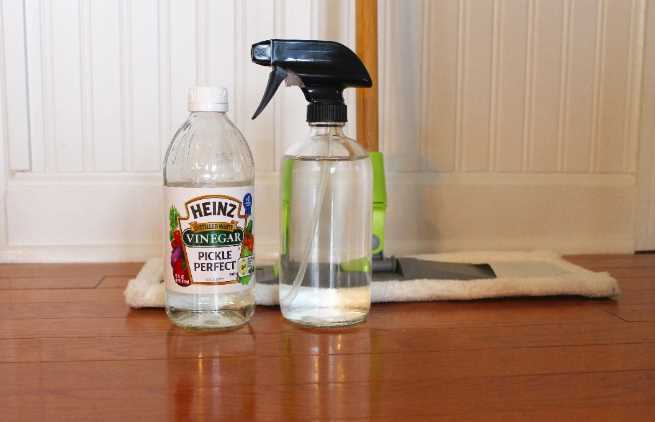
Prior to using the vinegar solution, sweep or vacuum the oak floors to remove any loose dirt, dust, or debris. This will prevent scratching or spreading dirt around during the cleaning process.
Test in a Small Area
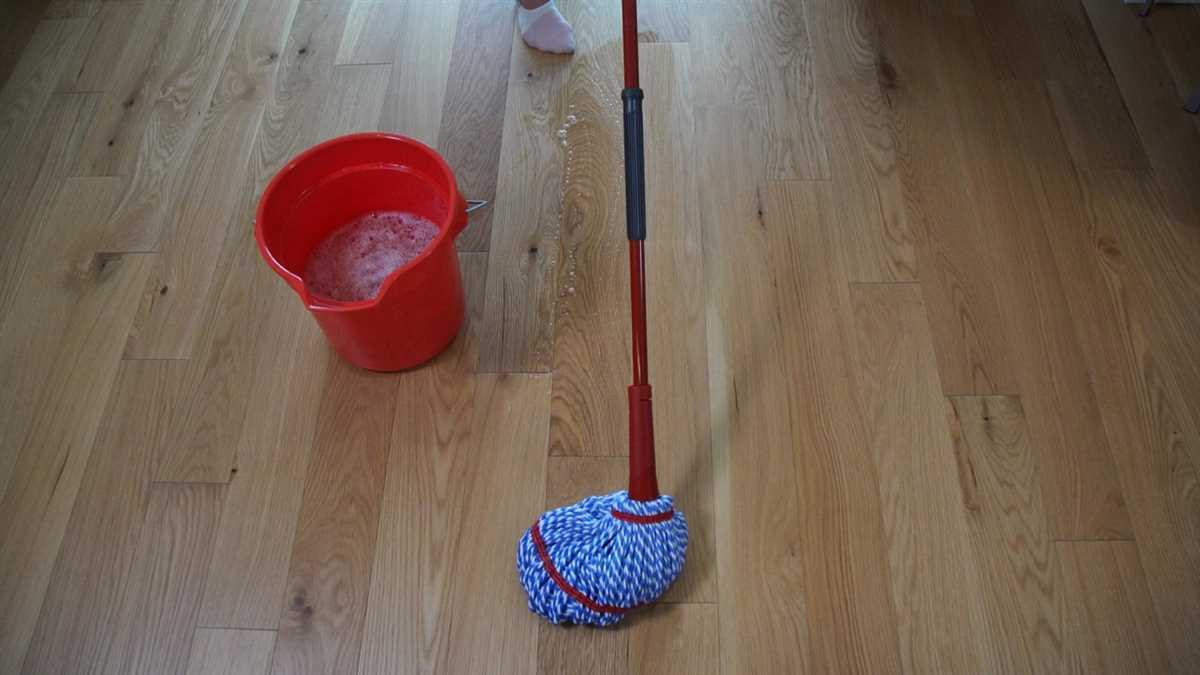
It’s always a good idea to test any cleaning solution on a small, inconspicuous area of your oak floors before applying it to the entire surface. This will help you ensure that the vinegar solution doesn’t cause any damage or discoloration.
Protect Baseboards and Walls
Before you begin mopping with the vinegar solution, take a moment to protect your baseboards and walls. You can use painter’s tape or plastic sheeting to cover these areas and prevent any splashes or spills from causing damage.
Prepare the Vinegar Cleaning Solution
In your clean bucket or container, mix equal parts vinegar and water to create your cleaning solution. For example, you could use 1 cup of vinegar with 1 cup of water. If desired, you can also add a few drops of essential oil for a pleasant scent.
Ready to Clean
Now that you’ve gathered your supplies, cleared the area, and prepared your cleaning solution, you’re ready to start cleaning your oak floors with vinegar. Dip your mop or microfiber cloth into the cleaning solution, wring out any excess liquid, and begin mopping the floor in a back-and-forth motion.
Note: Avoid using excessive water or saturating the oak floors with the vinegar solution, as it can damage the wood. It’s best to use a damp mop or cloth for cleaning.
Gathering the Necessary Cleaning Supplies
What you will need:

- Vinegar
- Water
- Microfiber mop or cloth
- Bucket
- Bristle broom or vacuum cleaner
- Dustpan
Why these supplies are necessary:
Vinegar: Vinegar is a great natural cleaner that can effectively remove dirt and grime from oak floors without causing any damage.
Water: Diluting vinegar with water helps to ensure that it is not too strong and doesn’t leave any residue on the floors.
Microfiber mop or cloth: Microfiber materials are gentle on oak floors and help to trap dirt and dust effectively, preventing scratching.
Bucket: A bucket is needed to mix the vinegar and water solution and to hold the cleaning solution while you work.
Bristle broom or vacuum cleaner: Before mopping, it’s important to remove any loose dirt and debris from the floor surface. A bristle broom or vacuum cleaner can help with this.
Dustpan: Used in conjunction with the broom or vacuum cleaner, a dustpan is necessary for collecting and disposing of the dirt and debris.
Preparing your cleaning solution:
- Fill your bucket with warm water.
- Add a 1:1 ratio of vinegar to the water. For example, if you have 1 cup of water, add 1 cup of vinegar.
- Mix the solution well to ensure the vinegar is fully incorporated.
Additional tips:
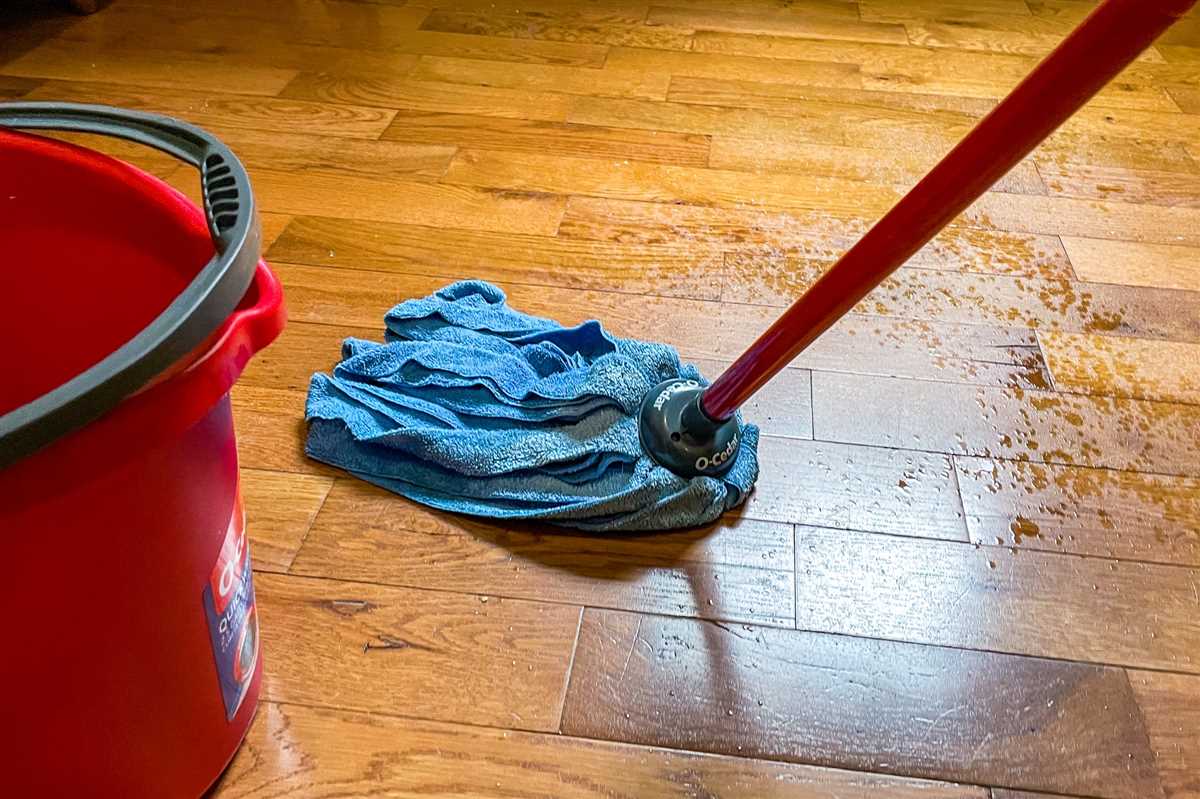
- Make sure to test the cleaning solution on a small, inconspicuous area of the oak floor before using it on the entire surface.
- Avoid using excessive amounts of water when cleaning oak floors, as this can cause damage.
- Regularly sweep or vacuum your oak floors to prevent dirt and debris from scratching the surface.
- Consider using a protective sealant on your oak floors to enhance their longevity and resistance to staining.
Step-by-Step Guide to Cleaning Oak Floors with Vinegar
Gather Your Supplies
Before you start cleaning your oak floors with vinegar, make sure you have all the necessary supplies:
- Bucket
- Mop or microfiber cloth
- Vinegar
- Water
- Soft-bristle broom or vacuum cleaner
Sweep or Vacuum the Floor
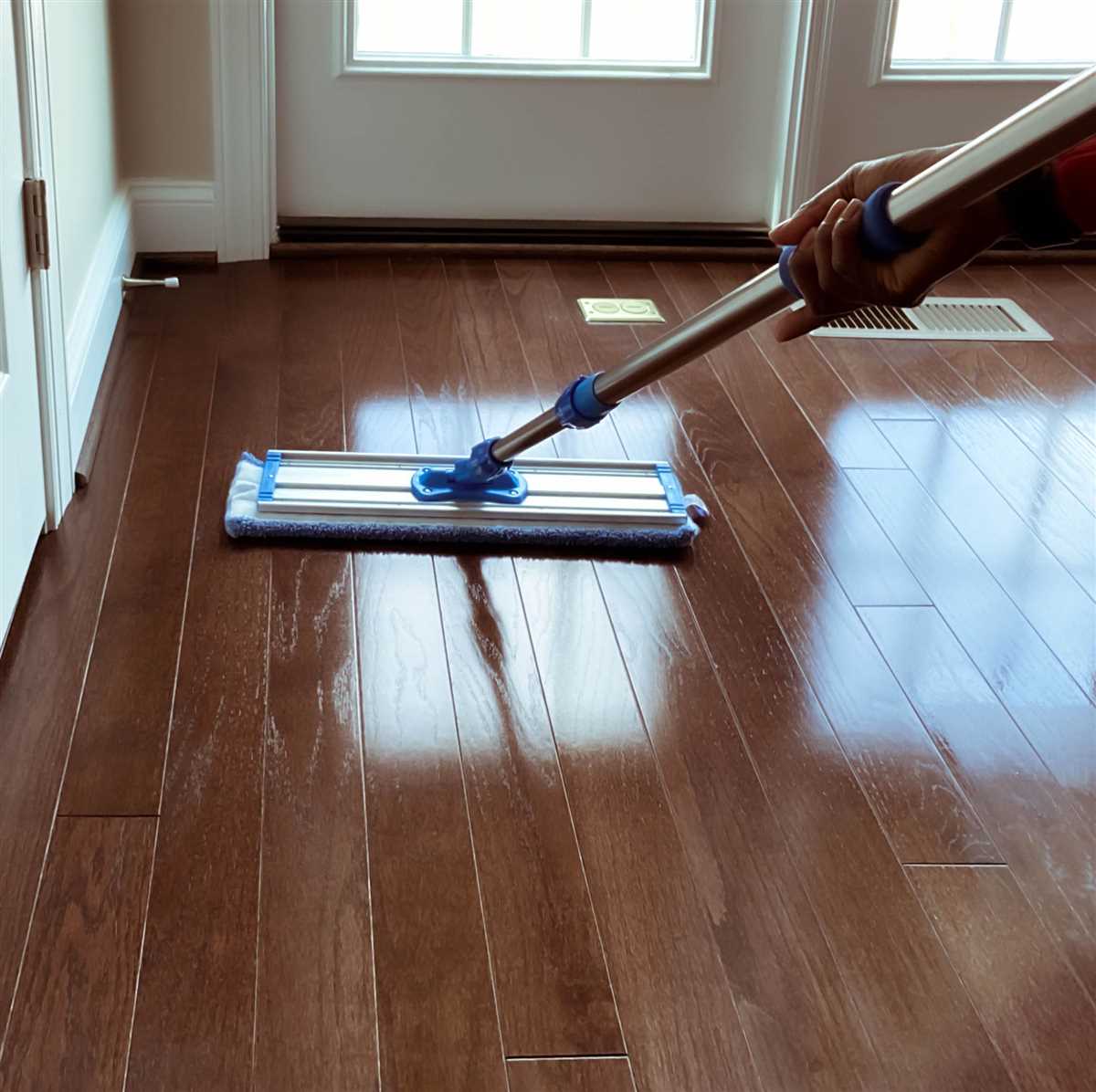
Begin by sweeping or vacuuming the oak floor to remove any loose debris, such as dust, dirt, or crumbs. Use a soft-bristle broom or a vacuum cleaner with a floor attachment to avoid scratching the wood surface.
Mix Vinegar and Water Solution
In a bucket, combine equal parts vinegar and water. For example, you can mix one cup of vinegar with one cup of water. This solution will effectively clean your oak floor without causing any damage.
Test the Solution
Before applying the vinegar and water solution to the entire floor, it’s essential to test it in a small, inconspicuous area. This test will ensure that the solution does not cause any discoloration or damage to the oak floor.
Clean the Oak Floor
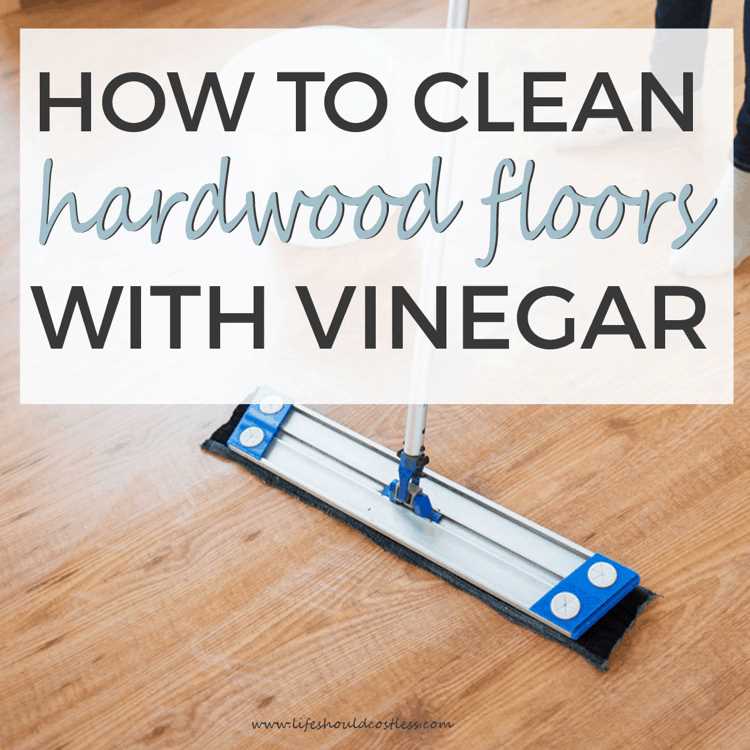
Dampen the mop or microfiber cloth in the vinegar and water solution. Wring out any excess liquid to avoid saturating the wood. Gently mop the oak floor, following the grain of the wood. Be careful not to leave excess liquid on the floor, as this can cause damage. If necessary, repeat this step in sections until the entire floor is cleaned.
Dry the Floor
After cleaning the oak floor, use a dry mop or cloth to remove any remaining moisture. This step is crucial to prevent water spots or damage to the wood. Ensure the floor is completely dry before allowing any foot traffic or placing furniture back on it.
Optional: Apply a Wood Floor Polish
If desired, you can apply a wood floor polish after cleaning the oak floor. This step will enhance the shine and protect the wood. Follow the instructions on the polish product for best results.
Regular Maintenance
To keep your oak floor looking its best, regularly sweep or vacuum to remove dirt and debris. You can also use a damp mop and the vinegar and water solution for a quick and effective clean. Avoid using harsh cleaners or excessive moisture, as these can damage the wood.
| Vinegar | Water |
|---|---|
| 1 cup | 1 cup |
| 1/2 cup | 1/2 cup |
| 1/4 cup | 1/4 cup |
Sweeping or Vacuuming the Oak Floors
One of the first steps in cleaning oak floors is to sweep or vacuum them to remove any loose dirt or debris. This is an important step as walking on dirty floors can cause scratches or damage to the surface.
Here are some tips for effectively sweeping or vacuuming oak floors:
- Use a soft bristle broom: Choose a broom with soft, natural bristles to sweep the oak floors. Hard bristles can potentially scratch the surface of the wood.
- Sweep in the direction of the wood grain: Sweep the floors in the direction of the wood grain to avoid pushing dirt or debris into the cracks and crevices.
- Use a microfiber mop or cloth: If you prefer to use a vacuum cleaner, make sure to use a brush attachment or a microfiber mop or cloth. This will help prevent scratching the wood floors.
- Adjust the settings of the vacuum cleaner: If you are using a vacuum cleaner, adjust the settings to the appropriate height for your oak floors. This will ensure that the vacuum cleaner effectively removes dirt without causing any damage to the wood.
By regularly sweeping or vacuuming your oak floors, you can keep them clean and free from dirt and debris, extending their lifespan and maintaining their natural beauty.
Tips for Maintaining the Shine and Beauty of Oak Floors
1. Regular Sweeping and Vacuuming
One of the easiest ways to maintain the shine and beauty of your oak floors is by regularly sweeping and vacuuming them. This helps to remove any dirt, dust, or debris that may cause scratches or dullness on the surface of the wood. Use a soft-bristle broom or a vacuum cleaner with a floor attachment to gently sweep or vacuum the floors.
2. Avoid Wet Mopping
When it comes to cleaning oak floors, it is important to avoid wet mopping. Excessive water can seep into the wood’s pores and cause damage, such as warping or staining. Instead, use a damp mop or cloth to gently clean the floors. Be sure to wring out the mop or cloth thoroughly to ensure it is only slightly damp.
3. Use pH-neutral Cleaners
When cleaning oak floors, it is important to use pH-neutral cleaners. Harsh chemicals or acidic cleaners can strip away the protective finish on the wood and cause it to become dull or damaged. Look for cleaners specifically designed for hardwood floors or check the labels to ensure they are pH-neutral.
4. Wipe up Spills Immediately
To prevent any potential damage to your oak floors, make sure to wipe up any spills immediately. Liquids can quickly penetrate the wood and cause staining or warping if left unattended for too long. Use a clean, dry cloth or paper towel to soak up any spills quickly and effectively.
5. Use Furniture Pads
Prevent your furniture from scratching or damaging your oak floors by using furniture pads. These small adhesive pads can be attached to the bottom of furniture legs or corners to provide a protective barrier between the furniture and the floor. Make sure to replace the pads regularly to ensure they are still effective.
6. Avoid Direct Sunlight
Direct sunlight can fade the color of your oak floors over time. To prevent this, use curtains, blinds, or window coverings to block out the harsh rays of the sun. You can also consider applying a protective film or UV-blocking coating to your windows to further reduce the potential damage caused by sunlight.
7. Regularly Buff and Polish
Every few months, it is a good idea to buff and polish your oak floors to maintain their shine and beauty. You can use a floor buffer or a soft cloth to gently buff the surface of the wood. Afterwards, apply a hardwood floor polish to enhance the natural shine and protect the wood.
8. Use Mats and Rugs
Place mats and rugs in high-traffic areas, such as in front of entryways or in hallways, to protect your oak floors from excessive wear and tear. These mats and rugs can help to trap dirt and debris from outside, preventing it from scratching or damaging the surface of the wood. Remember to regularly clean and shake out the mats to prevent any build-up of dirt or dust.
9. Avoid High Heels and Sharp Objects
Avoid walking on your oak floors with high heels or allowing sharp objects to come into contact with the wood. These can cause scratches, dents, or gouges on the surface, ruining the beauty of your floors. Consider using floor protectors on the bottom of chair and table legs to prevent them from causing any damage.
10. Keep Relative Humidity Levels Consistent
Fluctuations in humidity levels can cause the wood to expand and contract, leading to warping, splitting, or cracking. To maintain the beauty of your oak floors, it is important to keep relative humidity levels consistent in your home. Use a humidifier or dehumidifier as needed to keep the levels within the recommended range for hardwood floors.
FAQ
Can I clean oak floors with vinegar?
Yes, you can clean oak floors with vinegar. Vinegar is a natural and effective cleaner that can safely be used on oak floors.
How do I clean oak floors with vinegar?
To clean oak floors with vinegar, mix equal parts of vinegar and water in a spray bottle. Spray the solution onto the floor and mop it using a microfiber mop. Make sure to wring out the mop well to avoid excess moisture on the floor.
Is vinegar safe to use on all types of oak floors?
Vinegar is generally safe to use on all types of oak floors. However, it is always recommended to test the cleaning solution on a small, inconspicuous area of the floor before using it on the entire surface.
Can I use undiluted vinegar to clean oak floors?
No, it is not advisable to use undiluted vinegar to clean oak floors. The acidity of undiluted vinegar can potentially damage the finish of the floor. Diluting vinegar with water helps to reduce its acidity and make it safe for use on oak floors.
How often should I clean oak floors with vinegar?
The frequency of cleaning oak floors with vinegar depends on the amount of foot traffic and dust in your home. Generally, it is recommended to clean oak floors with vinegar once or twice a month. However, if your floors get dirty frequently, you may need to clean them more often.
What are the benefits of cleaning oak floors with vinegar?
There are several benefits of cleaning oak floors with vinegar. Vinegar is a natural and non-toxic cleaner, making it safe to use around children and pets. It is also an effective cleaner that can remove dirt, grime, and stains from the floor. Additionally, using vinegar can help to restore the shine and luster of oak floors.
Are there any alternative cleaners I can use for oak floors?
Yes, there are alternative cleaners that you can use for oak floors. Some options include commercial hardwood floor cleaners, mild dish soap diluted in water, or specific cleaners recommended by the manufacturer of your oak flooring. It is important to always follow the manufacturer’s instructions when using alternative cleaners.














